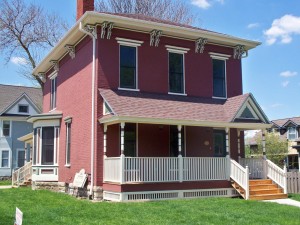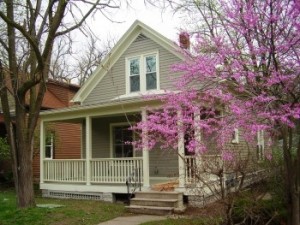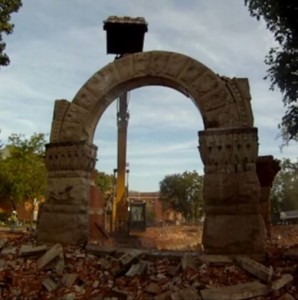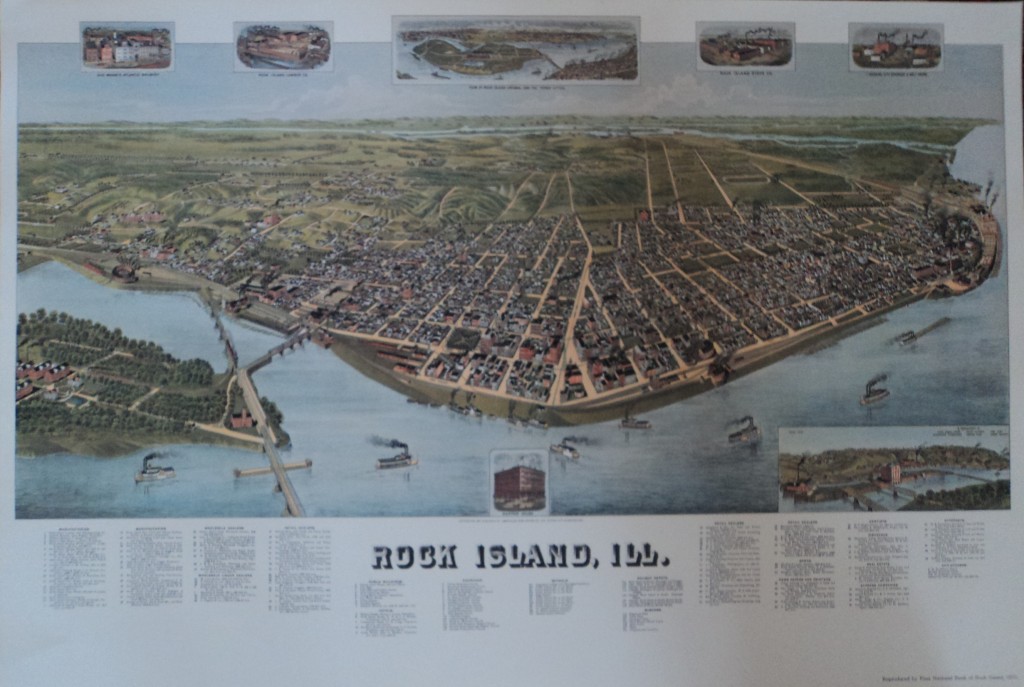May 2013
MEETINGS
- Monday, May 20, 6:45 pm – RIPS Award presentation at City Council, Third Floor of City Hall, 1528 Third Avenue. PLEASE be there a bit earlier as the awards are presented at the beginning of the meeting. Afterwards, we’ll quietly move to the basement conference room for a potluck snack reception to honor our award winners and have fun ourselves. Please bring something to share – you can leave it in the conference room before you go to the Council meeting. Make a real effort to come – it shows community support for preservation. Prior to the awards, the mayor will issue a proclamation declaring May as Preservation Month. *see 2013 Historic Preservtion Awards below
- Tuesday, June 18, 7 pm – Regular business meeting at home of Diane Oestreich, 816 22nd Street. This home was built by contractor John Volk for Frederick & Rose Titterington in 1904. Mrs. Titterington remained in the home until the mid 1940s and it has only had three owners since that time.
- Tuesday, July 23, NOTE: ERROR – it is JULY 16, 6:15 pm –It’s time for our annual summer potluck supper social meeting. We’ll have this indoors at Hauberg Civic Center, so we don’t have to worry about the weather. We’ll eat promptly at 6:30, so please come before that. Afterwards, we’ll have a special treat as Cynthia Empen presents a program on a nationally known artist, who grew up in Rock Island. (see page xx for more info) NOTE: if you don’t want to participate in the potluck, be at Hauberg at 7:15 for the program. (see related article below Irma Rene Koen).
MEMBERSHIP
Check the mailing label to see if you are a current member of RIPS. If you are, your label should read “Membership Expires Feb 14” which means 2014. If you’re not current, please send your check – $10 per person, to RIPS, P.O. Box 3261, Rock Island IL 61204-3261. Include your email address if you wish to receive emailed agendas and minutes every month. If your personal info hasn’t changed, all you need to send is your check. Occasionally we make a mistake – if you think you’ve paid but it doesn’t show on the label, just contact us.
STATEWUDE PRESERVATION CONFERENCE
Preservationists are invited to attend the 2013 Illinois Statewide Preservation Conference on June 27 – 29 in Evanston, Illinois. The conference is co-sponsored by Landmarks Illinois, the Illinois Association of Historic Preservation Commissions, and the Illinois Historic Preservation Agency. There are workshop sessions, walking tours of historic Evanston, and an opportunity to meet preservationists from across the state. See the complete program and the registration form at http://www.landmarks.org/workshops_and_conferences.htm
2013 HISTORIC PRESERVATION AWARDS
In celebration of National Historic Preservation Month in May, the Rock Island Preservation Society (RIPS) is presenting its annual Historic Preservation Awards and Certificates of Recognition for work completed during 2012. Public presentation of the awards will take place at the Rock Island City Council meeting on Monday, May 20.
Each year RIPS honors individuals, groups, or businesses who have made special efforts to preserve or restore historic structures in our community or whose actions have served to support historic preservation in Rock Island. Our awards are given primarily for exterior restoration that can be enjoyed from public right of way and are for work which was completed the previous year or, in some cases, earlier.
This year we are presenting Preservation Awards for two home projects; four Certificates of Recognition, also for home projects; and a Special Media Award for an inspiring documentary video.
Following is a listing of the Historic Preservation Awards, Certificates of Recognition, and the Special Media Award that will be presented. RIPS is pleased to provide photos of the projects at your request (see contact information above). Digital photos should be available by May 1.
HISTORIC PRESERVATION AWARDS
Levi Haverstick House, 544 23rd Street Honoree: Rock Island Economic Growth Corporation (GROWTH)
 This 1869 brick home in the Broadway Historic District is now a designated Rock Island Landmark. It was given a complete interior and exterior restoration and renovation under the Neighborhood Stimulus Program. Although the home had been maintained for much of its earlier life, it had been vacant for an extended period in recent years and had fallen into severe disrepair. The extensive exterior repairs involved reconstructing and restoring porches, including replacement of columns and balustrades on the front porch that had been missing for decades. Original windows were kept and repaired.
This 1869 brick home in the Broadway Historic District is now a designated Rock Island Landmark. It was given a complete interior and exterior restoration and renovation under the Neighborhood Stimulus Program. Although the home had been maintained for much of its earlier life, it had been vacant for an extended period in recent years and had fallen into severe disrepair. The extensive exterior repairs involved reconstructing and restoring porches, including replacement of columns and balustrades on the front porch that had been missing for decades. Original windows were kept and repaired.
House at 1603 25th Street Honoree: GROWTH 
Another project completed by GROWTH under the Neighborhood Stimulus program restored a small home in a prominent 25th Street location. The home was “unveiled” of its newer siding and a large front porch that had been enclosed for a long time was opened and restored, giving a much more welcoming view from the street.
SPECIAL MEDIA AWARD
Video – “Lincoln School: The Final Chapter” Honoree: Todd Mizener, Director of Photography, Argus/Dispatch
 During the demolition of Old Lincoln School, Mr. Mizener produced a short documentary showing the demo work in progress. During the past year, he also produced a longer historic documentary about the 150th Anniversary of the Rock Island Arsenal. However this Special Media Award singles out his moving production of a video which documents the fall of the last piece of the school left standing, the massive stone main entrance arch, “Lincoln School – The Final Chapter,” which can be viewed at http://blip.tv/qconlinevideo/lincoln-school-the-final-chapter-6353966
During the demolition of Old Lincoln School, Mr. Mizener produced a short documentary showing the demo work in progress. During the past year, he also produced a longer historic documentary about the 150th Anniversary of the Rock Island Arsenal. However this Special Media Award singles out his moving production of a video which documents the fall of the last piece of the school left standing, the massive stone main entrance arch, “Lincoln School – The Final Chapter,” which can be viewed at http://blip.tv/qconlinevideo/lincoln-school-the-final-chapter-6353966
CERTIFICATES of RECOGNITION
Garage at 816 23rd Street Honoree: Karolyn Williams
Located in the Broadway Historic District, the unique garage behind 816 23rd Street has a style that is almost like a commercial building. Rather than the common gabled roof, this 1920s era historic garage has an ornate parapet crowning its walls that conceals the actual roof. Ms. Williams restored the garage to its original appearance by removing later siding and protecting the metal parapet with extensive new metal flashing.
House at 1211 19th Street Honorees: Chris Dunn & Elizabeth Russell
This 1 ½ story home in the Broadway Historic District was “unveiled” as a neighborhood event. The owners then undertook the repairs that are always needed after unveiling, and painted the original clapboard in appropriate colors.
House at 905 20th Street Honoree: GROWTH
During their rehab project at 905 20th Street, GROWTH found it necessary to completely rebuild the front porch. This meant that the balustrade (railing) had to be higher than it was originally in order to meet current code standards. Thanks to skillful carpentry and a conscious effort to make it look right, it is not at all apparent from the street that the railing does meet modern codes. This is especially important for this house because it has a “twin” next door with the original porch. Note that the modern siding and new windows were present before the GROWTH renovation.
House and Garage at 1209 21st Street Honoree: GROWTH
When GROWTH began their renovation of the home at 1209 21st Street in the Broadway Historic District, it was important to retain the historic small garage. Needed repairs and a new door make this garage functional once again. Although the house exterior was largely original, stained glass window transoms were removed for repair and reinstalled.
IRMA RENE KOEN
Cynthia Wiedemann Empen, Independent Art Historian, will share the story of “A ‘Modern Painter’: The Early Life and Art of Irma René Koen.” Ms. Koen (originally Kohn) (1884–1975), grew up in Rock Island in the historic Queen Anne home at 824 23rd Street with her parents, Louis and Regina Kohn. It cost $5000 in 1894 when contractor Nicholas Juhl built it for the Kohn family. Even today, if you look closely at that house, Mr. Kohn initials and the numerals 94 cast in iron decorate the south chimney.
Cynthia will tell us about the early development and career of Ms. Koen, a painter, writer and lecturer, whose biography and artistic legacy have been largely forgotten. Described as “well known,” “famous” and “modern” in her own time, she was a trained landscape painter who studied with some of the era’s most influential art teachers. She traveled and exhibited extensively both nationally and abroad throughout her 70-year long career. Through research in local newspaper archives and correspondence with the artist’s family, Cynthia discovered a great deal about the reception of Koen and her art. She will also focus on the status of Midwestern women artists in an emerging modern culture. She’ll show pictures of some of Irma’s works and tell you where you can actually see one of her original paintings.
REHAB TAX CREDITS?
On April 24, the Illinois Senate passed, by a 46-8 margin, S.B. 336, the Illinois Rehabilitation and Revitalization Tax Credit bill. Sen. Mike Jacobs voted in favor of the bill, which will now go to the Illinois House. This is really “landmark” legislation, and will put Illinois on a fair playing field, because both Iowa and Missouri already have similar tax credits, which is one reason we see more development of historic buildings, especially schools, in Iowa, by for-profit corporations. If ultimately approved by the house, this bill would essentially parallel the federal 20 percent tax credit for designated historic buildings undergoing a certified (reviewed by the Illinois Historic Preservation Agency) to an additional 20 percent credit against Illinois income taxes. The potential economic benefits as millions of dollars are leveraged will be a boon to Illinois. Watch RIPS’ Facebook page for more details of the bill as it enters the House of Representatives, so that you can encourage your legislator to support it.
Landmarks Illinois, the statewide preservation advocacy group, of which RIPS is a member, is leading this movement.
ROCK ISLAND 1889 BIRDSEYE MAP
In 1975, First National Bank of Rock Island (no longer existing) reprinted the original 1889 birdseye map of our city. Some were donated to RIPS and we still have a limited number in our archives. The maps measure about 19 inches high by 28 inches wide and are in full color on high quality heavy paper. (Note: Reproductions of this map are available for a similar price online, they are not in color.) The depiction of buildings is amazingly detailed. One interesting feature of the map is that it shows the locations of the electric light towers that once ringed downtown Rock Island. If you would like to purchase one, just send your name and address and a check for $25 to RIPS, P.O. Box 3261, Rock Island IL 61204-3261.
We will either hand-deliver, arrange for pickup, or mail it to you if necessary. They have been stored flat so you don’t have to worry about dealing with a tightly curled map.
THE WALLACE GROVE NEIGHBORHOOD
It is a twist on an age-old question: Which came first, the neighborhood or the school? In 1908, the Rock Island School Board purchased five lots on 18th Avenue in an addition called Wallace Grove. The city directory that year listed only two addresses in the four block area between 26th and 28th Streets, 16th and 18th Avenues. In 1912, sixteen houses dotted the neighborhood and in September of that year a wood frame school building opened near the corner of 26th Street and 18th Avenue. The neighborhood and surrounding area continued to grow and soon the original Audubon School proved to be too small. The School Board purchased additional land and in 1912 a large two story, brick, state of the art, “fireproof” elementary school was built on the site. Three hundred and twenty-four students began their fall term in the beautiful building designed by Rock Island architect Benjamin Horn. One thousand five hundred people attended the formal dedication ceremonies. This beautiful building and its landscaped grounds were clearly a commitment made by a growing community to the education of its children.
The neighborhood north of the Audubon School was part of that growing community. It was a neighborhood of families, most of whom owned their homes. Occupations were varied including tradesmen, railroad employees, salesmen, school teachers, a school principal, an Augustana librarian, a postal carrier and an auditor. The homes were built over a period of 20 years and in a variety of architectural styles.
No fewer than four homes in this small Wallace Grove neighborhood north of Audubon School have been recognized for their architectural distinction by being listed on Rock Island Preservation Commission’s Most Significant Unprotected Structures List. Also listed is the unique group of bungalow-style courtyard apartments at 1605 26th Street known as Richard’s Bungalow Court.
The Clevenstine House at 1700 26th Street is a Bungalow-style home built in 1925. Stone is the most eye-catching feature of the home. It is used on the side walls of the porch steps, the porch piers and the front chimney. Cedar shakes provide the siding for the house including the large square columns on the front porch. Multiple gables mark the roofline. The home is thought to be a Gordon-Van Tine kit house…No. 612 “A Striking Three-Bedroom Bungalow” that varied from the catalog only by the addition of stone. Gordon-Van Tine was a Davenport millwork manufacturer that sold much of its millwork and building materials by catalog. It also supplied larger companies, notably Sears, Roebuck & Co., and in 1916 it entered the pre-cut housing market selling kit houses of its own. For more information on Gordon-Van Tine, visit www.gordonvantine.com. Traveling salesman, Emmert Clevenstine and his wife Lulu were the first of many owners of this truly distinctive home.
The Lundberg House at 1626 27th Street is a craftsman style house built in 1916 and owned for 35 years by Edward and Marie Lundberg. Craftsman features that are visible on this home include exposed braces and rafters, dormer walls covered with cedar shingles, and stucco porch piers supporting square tapered columns. But it is the chimney that grabs your attention. Granite boulders are large on the bottom, and then smaller stones follow a winding path upward to the chimney top that is again covered in large stones.
The Skallberg House at 1609 28th Street was built in 1911 and was the home of Emily Skallberg. The Shingle-style home, as its name implies, has its second story covered in shingles. The second story front gable extends out over the porch columns, allowing for an unusual recessed front porch. Although unusual, a very similar house sits at 1650 30th Street. The many oriel windows are a dominant feature of this house. An oriel window is like a bay that projects out from the wall, but does not reach the ground. The front gable features the largest oriel, with three windows. The oriel windows on the south side of the house use shingles to integrate them into the façade. The first floor of the house has a stucco finish and plain Tuscan columns supported by heavy, square stucco piers accent the front porch.
The Driffell House at 2605 17th Ave was first owned by Frank Perkins, but within one year it was purchased by Benjamin L. and Lillian Driffell, who would live here until around 1946. Ben Driffill was president of Driffill Printing Company. But he was equally well known for his meticulously cared for lawn. The house itself is a beautiful side-gabled Colonial Revival with exquisite detailing including triple dormers topped with modillions and pediments, modillions and dentil trim on the fascia boards, and Ionic capitals on the porch columns. Side porches are common on Colonial Revival homes, but this one with narrow windows and front-facing French doors is extra special.
May is National Historic Preservation month, and the past few years I have suggested that a great way to celebrate the occasion is to discover one of Rock Island’s older neighborhoods. This year, let me recommend Wallace Grove. Take a leisurely stroll around the neighborhood and while enjoying the architecture, ponder the question, which came first the neighborhood or the school? It is clear to me that Audubon School drew people to this hilltop neighborhood. The people who lived here were strong supporters of Audubon School. Audubon School, the building, continues today to be an important stabilizing anchor for a little know architecturally significant neighborhood being buffeted by change.
Linda Anderson, President
Rock Island Preservation Society
|
|




